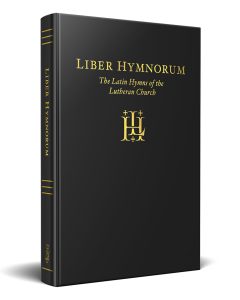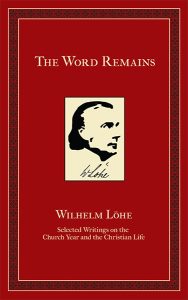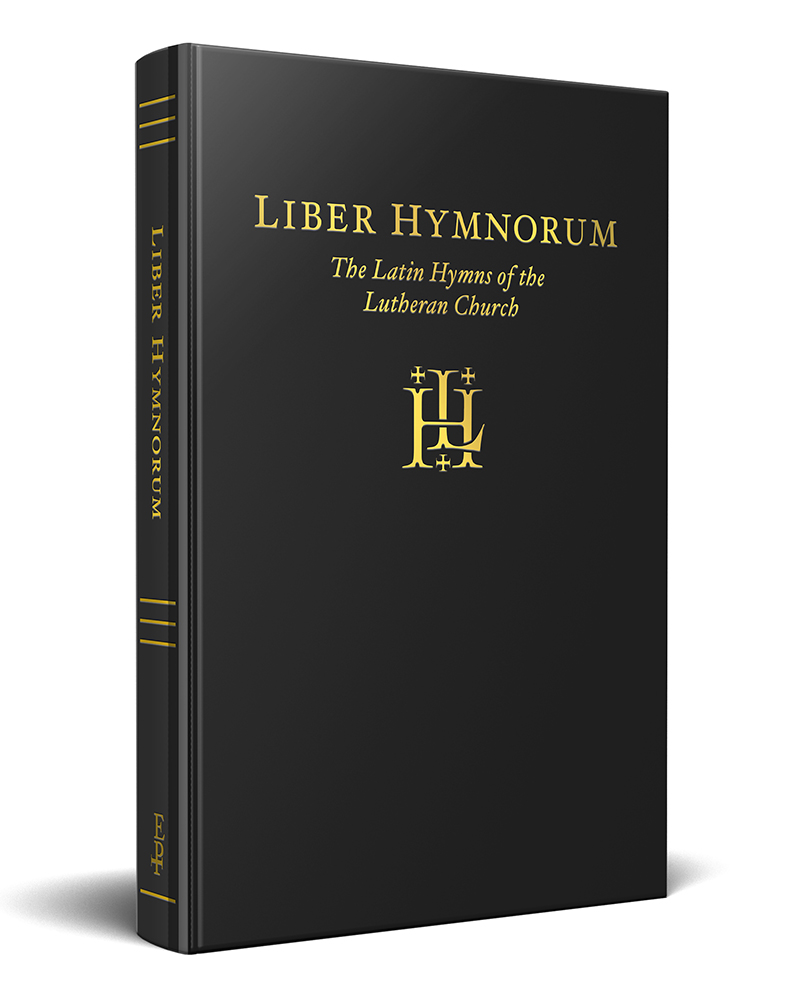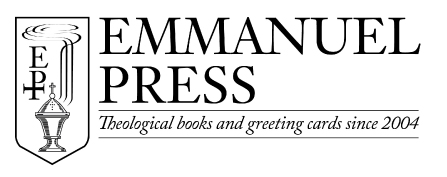THE LATEST NEWS
What resources are there to learn Gregorian chant?
 More from our interview with editor and translator Matthew Carver: “Basic instruction in Gregorian chant was not in view in this volume for a couple reasons: there are already great resources for it, and Liber Hymnorum was envisioned as a sort of supplement to other Lutheran chant resources already in use. That being said, anyone who knows how to read modern notation can use the music in the English section as a basis for learning all the Latin hymns and chants without knowledge of Gregorian chant, since they are (with few exceptions) largely the same, despite their different looks. So to keep down the size and price of the volume while simultaneously providing as many of these hymns and chants as possible, I’ve left instruction in Gregorian chant to others.
More from our interview with editor and translator Matthew Carver: “Basic instruction in Gregorian chant was not in view in this volume for a couple reasons: there are already great resources for it, and Liber Hymnorum was envisioned as a sort of supplement to other Lutheran chant resources already in use. That being said, anyone who knows how to read modern notation can use the music in the English section as a basis for learning all the Latin hymns and chants without knowledge of Gregorian chant, since they are (with few exceptions) largely the same, despite their different looks. So to keep down the size and price of the volume while simultaneously providing as many of these hymns and chants as possible, I’ve left instruction in Gregorian chant to others.
“First, if you have The Brotherhood Prayer Book and its accompanying CD, you already have a good introduction to Gregorian chant that will give you all you need to sing from the Latin section of Liber Hymnorum. (A Liber Hymnorum CD is also in the works!) There are several online resources, too, such as “An Idiot’s Guide to Square Notes” and the Corpus Christi Watershed site, which includes instruction and audio examples in How to Read and Sing Gregorian Chant. There is an active group on Facebook called “Gregorian Chant is for Everyone” as well as a group devoted to The Brotherhood Prayer Book (“Lutheran Liturgical Prayer Brotherhood”), where questions concerning chant can be answered. In short, there is little to keep people from learning to sing from Gregorian notation—in fact, once you get the basics from one of these resources, you find it really is simpler, more flexible, and more forgiving than standard modern notation!
“As far as Latin pronunciation is concerned, we’ve normalized the old Reformation-period spelling so that it can be pronounced according to the classical method or the Roman or German ecclesiastical (church Latin) method, though for the sake of rhyme the latter is preferred. Some instructions in pronouncing churchly Latin can be found here, and there is a good comparative table in the Wikipedia article “Latin regional pronunciation.” Students of Latin may find it best to use the accent familiar to them from their curriculum. In any case, when singing with others, it is wise to agree on the method of pronunciation beforehand!”
Pr. Rob Paul reviews Liber Hymnorum
 “Liber Hymnorum is yet another example of Mr. Matthew Carver’s ability and propensity to deliver to our generation the great, lost treasures of the Evangelical Lutheran Church’s past. Mr. Carver and Emmanuel Press have done the churches and schools of the Church a great service by editing and publishing such a fine volume of hymns.
“Liber Hymnorum is yet another example of Mr. Matthew Carver’s ability and propensity to deliver to our generation the great, lost treasures of the Evangelical Lutheran Church’s past. Mr. Carver and Emmanuel Press have done the churches and schools of the Church a great service by editing and publishing such a fine volume of hymns.
“The Liber consists of a significant introduction, two sections of hymns, and significant indices for hymn enthusiasts and scholars alike. The introduction details not only the contents and thought behind the volume, but also provides significant information about the hymns and hymn books of the early Lutheran Church. Each hymn comes from the Lutheran books of the sixteenth and seventeenth centuries. Here readers are introduced to the names of Lucas Lossius and Matthäus Ludecus, among others. Liber Hymnorum promises to provide not only a wealth of resources for the scholar of Lutheran hymnody and Latin hymnody, but also a useful volume for the classical schools, choirs, teachers, and pastors of our Church.
“With regards to the hymnal itself, first, there are English hymns for use during the week, the Church Year, for feasts and festivals, and for general and seasonal use. Second, the same hymns are presented in their original Latin texts. The English portion of the hymnal provides the tunes of the hymns in modern music notation. This provides a level of accessibility to these hymns of the Church that has not existed before. Many hymns will be new; however, some popular favorites are represented in this volume (In Dulci Jubilo, “Lord Keep Us Steadfast in Your Word,” “Creator of the Stars of Night,” and “Savior of the Nations Come,” among others). The Liber also exposes the Church to the wide breadth of hymns written for specific times and occasions that have been hidden from the Church’s use for so long.
“In the Latin portion, these hymns are presented in Gregorian notation. Since the same hymns are presented in modern music notation earlier in the hymnal, these tones are now more accessible for the musically inclined. One thing that is lacking is an explanation of neumes – that is, Gregorian notation – or at least references that direct novices towards more material if they are interested. The Brotherhood Prayer Book is referenced in the introduction, and it contains such material. But for use in schools, if pastors and teachers wish to educate on Gregorian notation, a supplement to this hymnal is necessary.
“Finally, the indices provide novices and scholars alike with resources concerning the tones used throughout the hymnal. The indices also contain comprehensive lists of the authors, composers, and sources contained in the book.
“Liber Hymnorum looks to be a volume worthy of any classical Lutheran school, Latin student, music student, Lutheran pastor or musician, or even the avid layperson. What once was inaccessible to most is now available to many in a great and friendly format. The Liber is a useable hymnal with great potential. It is my hope that classical Lutheran schools, church youth and adult choirs, pastors and laity alike will take advantage of this resource in order to better understand and embrace the rich heritage Lutherans have in the Latin hymnody presented in Liber Hymnorum.”
-Rev. Robert W. Paul, Pastor and Headmaster, Immanuel Lutheran Church and School, Roswell, NM; Board Member of the Consortium for Classical Lutheran Education (CCLE)
*In our next post, Matthew Carver will answer the question, “What resources are there to help learn Gregorian chant?” Like us on Facebook or sign up for email updates on the right sidebar.
Pless endorses The Word Remains by Wilhelm Löhe
 “Wilhelm Loehe (1808-1872) was one of the church fathers of the 19th century, to use the description of Hermann Sasse. His pastoral wisdom combined with a zeal for Lutheran missions marked Loehe’s life and work. In this collection, the voice of Pastor Loehe speaks across the years into our own time and place. Insightful, brief commentaries on the days and seasons of the church year along with pithy sayings on the Christian life will provide readers with much to kindle their hearts and minds for meditation and prayer. This is a devotional classic which will continue to edify and enlighten both pastors and laity.” -Prof John T. Pless
“Wilhelm Loehe (1808-1872) was one of the church fathers of the 19th century, to use the description of Hermann Sasse. His pastoral wisdom combined with a zeal for Lutheran missions marked Loehe’s life and work. In this collection, the voice of Pastor Loehe speaks across the years into our own time and place. Insightful, brief commentaries on the days and seasons of the church year along with pithy sayings on the Christian life will provide readers with much to kindle their hearts and minds for meditation and prayer. This is a devotional classic which will continue to edify and enlighten both pastors and laity.” -Prof John T. Pless
*Purchase The Word Remains along with Liber Hymnorum: The Latin Hymns of the Lutheran Church — and save 10% on both!
A quick note about purchasing Liber Hymnorum
Today we received word from our printer that Liber Hymnorum is ready! We’re heading to Ohio tomorrow to pick up the books so that we can have them available at the “Lutheranism and the Classics” conference in Fort Wayne. This has really been down to the wire, but we are thrilled that we can debut Liber Hymnorum with author Matthew Carver in person. The book will be released on this website on Friday, September 30. If you want to know when the page is live, like us on Facebook or sign up for email updates on the right sidebar.
How would Liber Hymnorum be used devotionally?
 “Liber Hymnorum is arranged according to the church year, with the ‘de tempore’ (times and seasons) in the front and ‘de sancto’ (saints and festivals) in the back of each section. This makes use in home or church fairly simple and straightforward. Christians, through these hymns, find expression for their own spiritual sentiments in response to God’s gifts each hour and day and reflect on the themes of the season or feast, tying in with what happens at church. The prayer service hymns (hymns of the daily office, or Liturgy of the Hours) especially can and should be used by Christians at home as well as in those churches where Matins and Vespers are offered. A regular course and use of these ancient hymns anchors the mind and heart to the hours, days, seasons, and all time as God arranges it.
“Liber Hymnorum is arranged according to the church year, with the ‘de tempore’ (times and seasons) in the front and ‘de sancto’ (saints and festivals) in the back of each section. This makes use in home or church fairly simple and straightforward. Christians, through these hymns, find expression for their own spiritual sentiments in response to God’s gifts each hour and day and reflect on the themes of the season or feast, tying in with what happens at church. The prayer service hymns (hymns of the daily office, or Liturgy of the Hours) especially can and should be used by Christians at home as well as in those churches where Matins and Vespers are offered. A regular course and use of these ancient hymns anchors the mind and heart to the hours, days, seasons, and all time as God arranges it.
“The melodies are given in standard notation (resembling the stemless chants found in our modern hymnals) as well as the original Gregorian notation. For those able to read Gregorian notation (a worthy endeavor; not as hard as it looks!), the Latin hymns are completely underlaid, so there is no guesswork in which syllable goes on which note, leaving the mind freer to contemplate the spiritual depths of the text (or at least, to grasp the basic meaning of the Latin!).”
–Matthew Carver: author, editor, and translator

Let’s stay in touch! To receive the most current information on our products and new releases, join our email list today!

